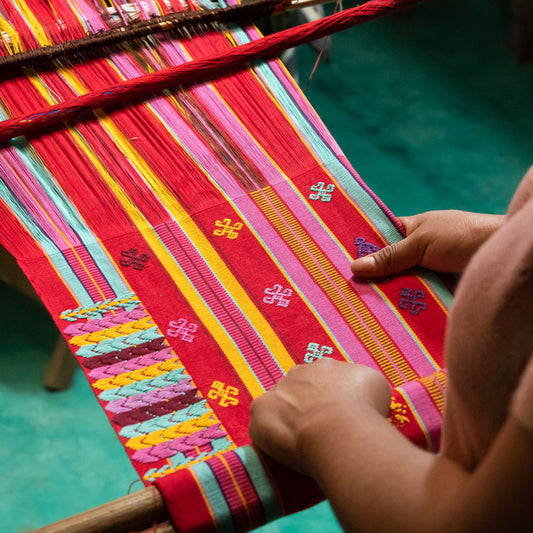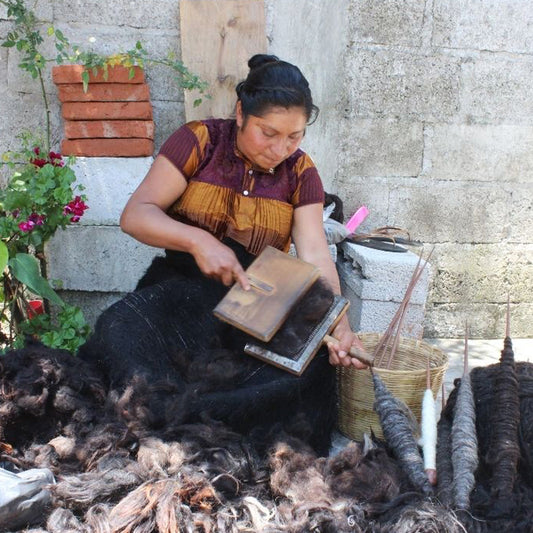Nora Lorek, a photographer for National Geographic, was on assignment documenting the journey of refugees on their way from South Sudan to Uganda. She asked residents what they’d brought from home when fighting intensified in 2016. “Nothing,” one woman replied, “except for some clothes wrapped in my bedsheet.” When Nora asked around, more women retrieved their milayas—an ornately embroidered sheet—posing for portraits that were featured in National Geographic magazine.
Refugees walked for days or weeks carrying these sheets, decorated with swirls of flowers, trees, and animals. Before the war milayas were used for dowries and celebrations, but now, after years of violence, they held the refugees’ last possessions. The civil war in South Sudan has displaced more than two million people. Today, in Bidibidi, the second largest refugee camp in the world, women continue to sew milaya. They’re hung at church on Sundays, and decorate funerals and weddings. After a successful Kickstarter campaign, Nora and National Geographic writer Nina Strochlic successfully established a non-profit connecting international customers with South Sudanese women making hand-embroidered pillowcases, bedspreads, and wall hangings.

Since your first interaction with the women in the Bidibidi camp, can you describe the motivations and steps that led you to forming The Milaya Project?
As soon as Nora’s photographs published in National Geographic alongside a short story written by Nina we began getting a flood of emails from people asking how they could purchase the sheets. We had no idea what to tell them. The real answer was they would have to fly to Uganda and then drive 12 hours to reach Bidibidi camp. That wasn’t going to work, so, when we returned to Bidibidi to write a story about how the refugee camp was developing into a city a few months later we purchased as many milayas as we could. We sold those on our Kickstarter and that was the foundation that we build the Milaya Project on.

How many women and children are in the Bidibidi camp, and what are the greatest challenges they face, currently during COVID and previously?
Around a quarter million refugees live in Bidibidi, and the vast majority are women and children. When war broke out in South Sudan, many fled while their husbands stayed behind to fight or protect their property. The women we work with are often the primary breadwinners in their family—they’re farming, cooking, cleaning, fetching water, and raising the children. It’s very common to meet a woman who’s caring for not just her own children, but her nieces and nephews, and orphans she’s taken in. The hardships have been exacerbated by COVID—many NGOs have closed their operations, meaning lots of people have lost jobs, and food rations have been cut. It’s a really difficult time compounding a terrible humanitarian crisis.
What do the female artisans think of international appreciation for milayas and their skills?
We always make sure to show the women we work with pictures of where their milayas end up—whether it’s on a couch in Sweden or framed on a wall in Arlington, Virginia. One of the women we work with, Rose Juan, is a mother of four who runs a small collective of milaya makers in the camp. During our last joint visit, we asked her what she thought of the fact that her work was being sent out across the world. “Making milayas has been passed down from grandparents to parents to kids,” she told us. “It makes me happy to know what my parents passed down to me is being looked at as important. I feel appreciated and feel my parents are appreciated as well.”

How do you see the future for these women, and what is the goal?
Our goal is to provide a sustainable livelihood for women living in Bidibidi. We hope someday they will be able to return to their homes in South Sudan, but for now, if we can help them improve their lives by providing an income, that’s where we fit in! We are currently overseeing the operation as volunteers and would love to someday transition it to our staff in Uganda so it can be locally run.
Another goal is to preserve the tradition of milaya making, as it can be cost prohibitive for them to do on their own. The women we work with tell us that being able to gather together at the center to embroider is a highlight of their week—a small break from their daily grind. “At home I’d spend my life stressing over how to take care of my kids,” master embroiderer Susan Brusaba told us. “This group is like having a family to rely on. They support me. If I get sick these women help me, they look after me.”



